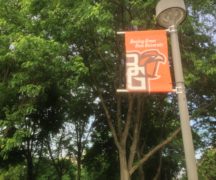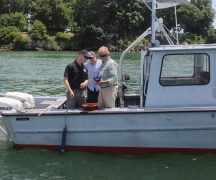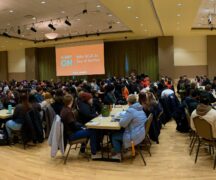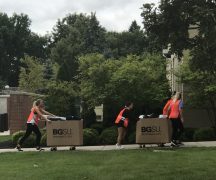By DAVID DUPONT
BG Independent News
Enrollment for the fall at Bowling Green State University is down 2.4 percent.
University officials Tuesday released its 15-day enrollment data, which showed enrollment on the Bowling Green campus declining 1.2 percent from 17,650 to 17,361.
Undergraduate enrollment at the main campus including online students is down 1.2 percent to 14,857. The Firelands campus is down 8.9 percent.
Cecilia Castellano, vice provost for strategic enrollment planning, said that the drop at Firelands is a loss of returning students. She attributed that to strong job market in the area, which is causing students to put off their studies.
However, Firelands saw a 14-percent increase in first year students.
On the Bowling Green campus, she described undergraduate enrollment as virtually flat.
The incoming class is also smaller than last year’s 3,590. But those 3,480 students are the most academically prepared in BGSU’s history. That’s the fifth year that’s the case, said Dave Kielmeyer, the university chief communications officer.
The class has an average ACT score of 23 with a grade point average of 3.45, Castellano said.
University officials hope these students will be better prepared to succeed and stay at BGSU and eventually graduate. State higher education funding is largely based on how many students a university retains and graduates.
Castellano said that the retention rate from first to second year at BGSU increased by just over 1 percent to 77 percent. The goal is to reach 80 percent.
Later in the day, President Mary Ellen Mazey told Faculty Senate that other universities, including Kent State, have already topped that marked. She said BGSU needs to reach 80-percent retention “sooner rather than later.”
Castellano said: “I do feel we have had great success this year moving the needle.”
That’s a result of bringing in a “strong freshman class” as well as advising initiatives and analyzing data to determine what students are struggling and at risk of dropping out so they can be given help.
College Credit Plus, which helped boost enrollment last year, was credited with some of the slight decline. Castellano said that a number of schools that partner with BGSU to provide college courses to high school students have moved that program to spring semester. So she expects a bump in spring when the students come back on the rolls.
Also, she noted, BGSU has increased its admission requirements and that means fewer high school students are eligible.
Mazey told faculty senate that the key to strengthening enrollment is developing new academic programs that respond to the needs of the workplace.
Castellano said that aviation, exercise science, the new software engineering, business, accounting, biology and other sciences. Offerings in forensic science and criminal justice also “continue to be strong,” Castellano said.
Also strong is the Pathways Program which allows students to be accepted at Firelands but live on the Bowling Green campus. “They get quite a bit of support in and out of the classroom,” she said. “We’re just making sure they are well prepared, and making sure they graduate.”
The program now has 118 students, more than double the 48 students enrolled last year. Those students are included in the Firelands’ headcount.
Graduate enrollment is down 4.1 percent to 2,673 from 2,793. Dean of the Graduate College Peggy Booth attributed the decline to a number of factors.
One, last year the college graduated an especially large number of students, 1,075. That’s 111 more than the previous year. On the years previous the number of graduates with advanced degrees was in the 900s, she said.
The number of students coming in, she added, is also down 1.9 percent.
Booth noted that while domestic enrollment was up by 31 percent, international enrollment was down 24.7 percent. This is attributable in part, she said, to the domestic political climate.
Also, students both graduate and undergraduate are finding it more difficult to get visas. “We have students in limbo,” she said. “They’ve been accepted. They’ve been admitted. But they are having trouble getting visas.”
This disproportionately affects the Graduate College.
India, which historically has sent the most international students to BGSU, is undergoing a financial crisis with less government money available to support students.
Castellano said that the trend for students to favor universities in other English speaking countries has been evident for the last several years.
Universities nationwide are experiencing these problems, not just BGSU, Booth said.
BGSU has been working to develop professional graduate programs. These are aimed at working professionals who want to get a graduate degree or credentials. These students typically pay full tuition and do not need the financial support that students in more traditional programs receive.
Some of those, such as master degrees in computer science and analytics have felt the crunch because of fewer international students. “We’re going to try to reposition those a little bit to make them more open to professionals in the region who want to work on masters,” Booth said.
Typically these programs are a blend of on-campus and online courses.
Another reason for the decline in graduate enrollment, she said, is that a cohort of high school teachers who were working to earn credentials to teach College Credit Plus courses, have passed through the system.
BGSU received a state grant to pay for training those teachers.
Some, Booth said, are continuing on to receive a master’s degrees.
Two new graduate programs are doing well, she said. A master’s in social work with a gerontology specialty has a full contingent of students, which is unusual for a new program. Also, a master’s in forensic science has also attracted students.
More programs, Booth said, are in the works.





